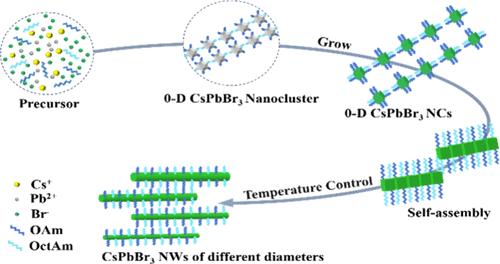基于油胺-辛胺体系的CsPbBr3纳米线直径控制及光学性能研究
IF 3.2
3区 化学
Q2 CHEMISTRY, PHYSICAL
引用次数: 0
摘要
金属卤化物钙钛矿(MHPs)由于其优异的光电转换效率和可调谐的能带结构而成为光电子学领域的重要材料。传统的钙钛矿纳米晶合成系统通常使用油酸(OA)来加速结晶动力学,这无意中阻碍了纳米线的生长和形态控制。在本研究中,我们采用了一种双配体体系,它是由油胺(OAm)和辛胺(OctAm)组成的,没有预先添加OA。通过后注入油酸铯溶液,我们实现了对Pb2+离子释放的精确控制,实现了在100-160°C范围内可控合成卤化铯铅纳米线(CsPbBr3)。这种策略产生了微米级的纳米波,直径可调(8.3-12.6 nm),长度达到微米级。温度相关的光学研究表明,升高的合成温度减弱了量子约束效应,导致紫外-可见(UV-vis)吸收(505-507 nm)和光致发光(PL)发射(516-518 nm)峰的系统红移。同时,时间分辨PL测量显示载流子寿命显著增强(24.72-91.99 ns),反映了非辐射重组途径的减少。变温PL光谱(80-300 K)表明,与在120℃下制备的样品相比,在140℃下合成的CsPbBr3 NWs具有更高的激子结合能(Eb = 44.7 meV)和增强的激子-声子耦合强度(ΓOP = 46.48 meV)。这些发现表明,高温合成赋予CsPbBr3 NWs优越的热稳定性。我们的工作不仅阐明了胺配体在调节NW生长动力学中的关键作用,而且为设计稳定、高性能、一维钙钛矿光电材料提供了一个强大的框架。本文章由计算机程序翻译,如有差异,请以英文原文为准。

Diameter Control and Optical Properties of CsPbBr3 Nanowires Based on the Oleylamine–Octylamine System
Metal halide perovskites (MHPs) have emerged as prominent materials in optoelectronics due to their exceptional photoelectric conversion efficiency and tunable band structures. Traditional perovskite nanocrystal synthesis systems often employ oleic acid (OA) to accelerate the crystallization kinetics, which inadvertently hinders nanowire growth and morphology control. In this study, we adopted a dual-ligand system using oleylamine (OAm) and octylamine (OctAm) without preadding OA. By postinjecting a cesium oleate solution, we achieved precise control over Pb2+ ion release, enabling the controllable synthesis of cesium lead halide (CsPbBr3) nanowires (NWs) across 100–160 °C. This strategy yielded micrometer-scale NWs with tunable diameters (8.3–12.6 nm) and lengths reaching the microscale. Temperature-dependent optical studies revealed that elevated synthesis temperatures weakened quantum confinement effects, leading to systematic red-shifts in ultraviolet–visible (UV–vis) absorption (505–507 nm) and photoluminescence (PL) emission (516–518 nm) peaks. Concurrently, time-resolved PL measurements revealed a significant enhancement in carrier lifetime (24.72–91.99 ns), reflecting reduced nonradiative recombination pathways. Variable-temperature PL spectroscopy (80–300 K) demonstrates that CsPbBr3 NWs synthesized at 140 °C exhibit higher exciton binding energy (Eb = 44.7 meV) and enhanced exciton–phonon coupling strength (ΓOP = 46.48 meV) compared to samples prepared at 120 °C. These findings demonstrate that high-temperature synthesis confers superior thermal stability on CsPbBr3 NWs. Our work not only clarifies the critical role of amine ligands in modulating NW growth dynamics but also provides a robust framework for designing stable, high-performance, one-dimensional perovskite optoelectronic materials.
求助全文
通过发布文献求助,成功后即可免费获取论文全文。
去求助
来源期刊

The Journal of Physical Chemistry C
化学-材料科学:综合
CiteScore
6.50
自引率
8.10%
发文量
2047
审稿时长
1.8 months
期刊介绍:
The Journal of Physical Chemistry A/B/C is devoted to reporting new and original experimental and theoretical basic research of interest to physical chemists, biophysical chemists, and chemical physicists.
 求助内容:
求助内容: 应助结果提醒方式:
应助结果提醒方式:


